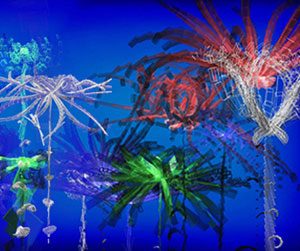Fractal Flowers, interactive virtual reality installation, 2010 ι Computer program: Cyrille Henry
Herbarius 2059, video, 35 min., 2009

Miguel Chevalier presents two works addressing a botanical world issued from a human conception. In Herbarius 2059, shown in the ante-chamber, he individually introduces twelve species of flowers. These flowers reappear as part of Fractual Flowers 2010 featured in the adjoining room, in which a computer program generates a virtual flower garden which multiplies itself ad infinitum. The flowers grow, bloom, mature, die, and disintegrate before the viewer’s eyes. Being manmade, as opposed to natural, the flowers in this garden are unusual: they are beautiful and at the same time threatening and mysterious.
Continue Reading...
This duality was inspired by Baudelaire’s renowned book of poems, Les Fleurs du Mal (The Flowers of Evil), where he endeavored to extract beauty from the malignant. Unlike traditional poetry which relies on the serene beauty of the natural world to convey emotions, Baudelaire felt that modern poetry must evoke the artificial and paradoxical aspects of life. He thought that beauty could evolve on its own, irrespective of nature, and sometimes prompted by sin. Accordingly, Chevalier’s beautiful and malignant flowers have lives of their own, irrespective of their traditional role in nature. Incorporating elements from the mineral, mechanical, and animal worlds, these flowers surprisingly possess a will of their own, and bend in response to passersby. By assuming the role of creator (or genetic modifier), man interferes with the laws of nature which previously defined the traditional boundaries of the botanical world. In consequence, these man-engineered flowers transgress their traditional static role and “invade” the human world by reacting to what occurs in it.
Less Reading...
